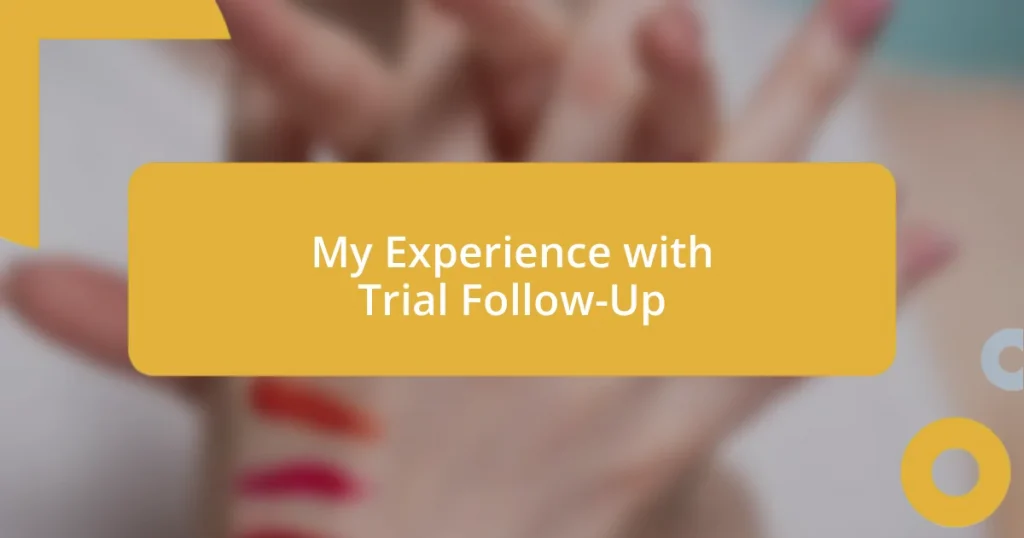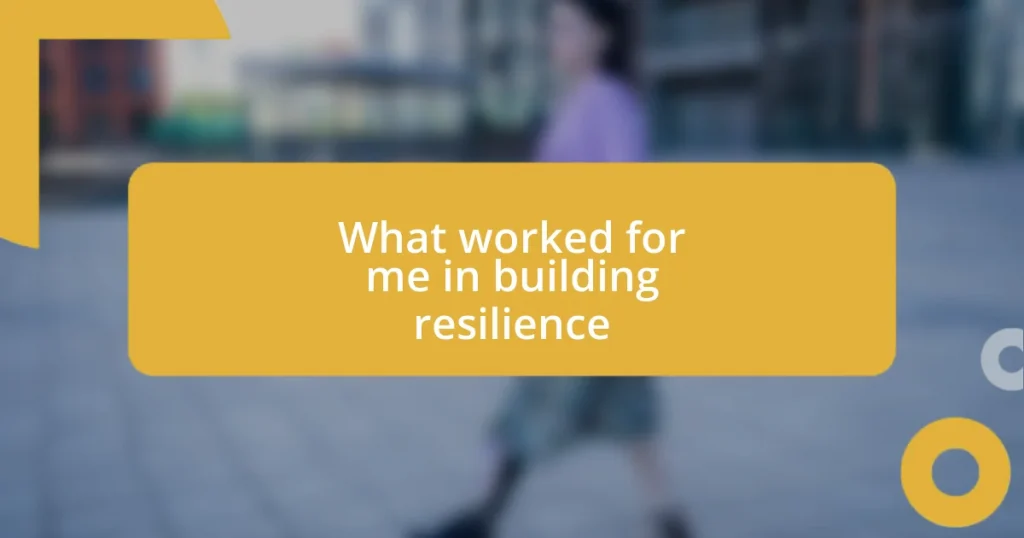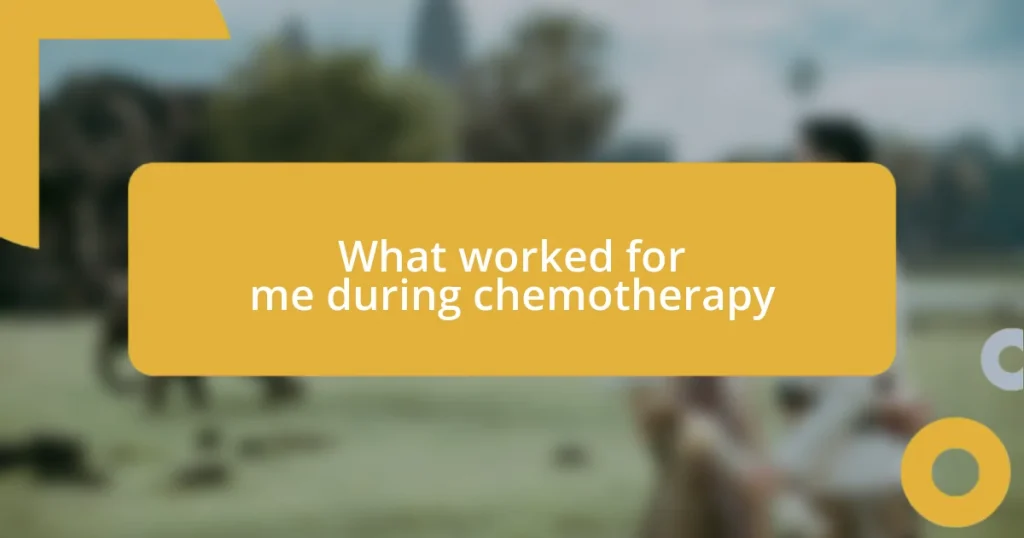Key takeaways:
- Timely and personalized follow-ups enhance participant trust and provide critical feedback for improving future trials.
- Effective communication through active listening and flexible conversation frameworks fosters deeper participant engagement and insightful responses.
- Utilizing feedback from participants to refine processes promotes a culture of openness and strengthens the connection between researchers and participants.
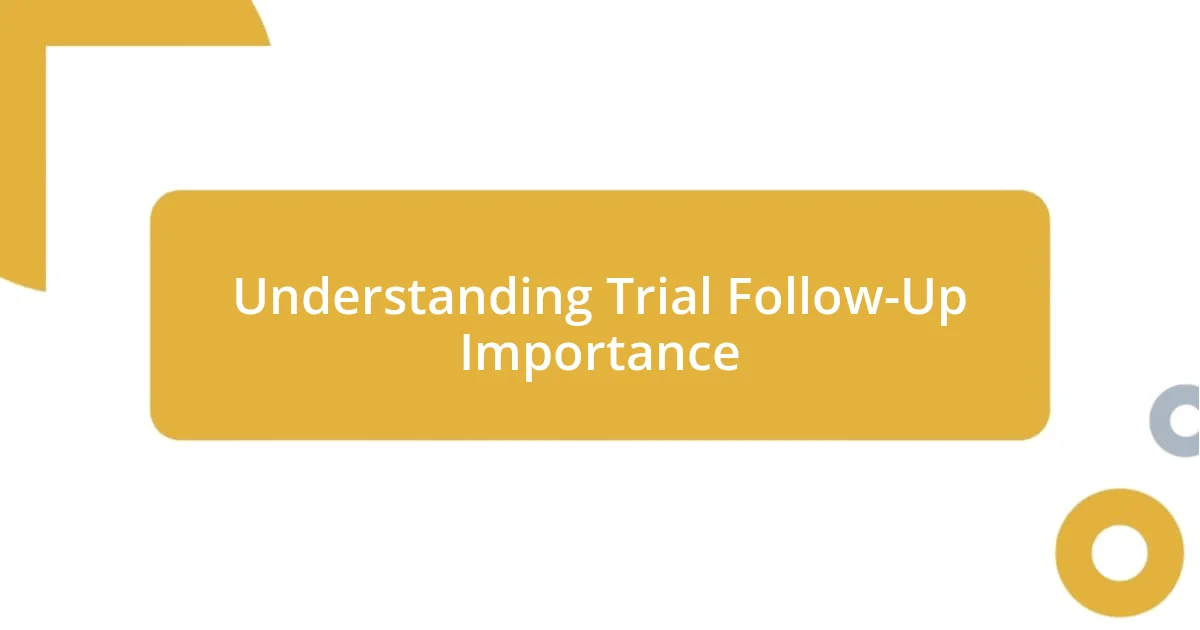
Understanding Trial Follow-Up Importance
Trial follow-up is not just a procedural formality; it’s the heartbeat of effective patient care. I’ve seen firsthand how consistent follow-up can make a significant difference in a participant’s recovery journey. For instance, one of my patients, after completing a trial, expressed feelings of uncertainty about their health. A simple follow-up call reassured them, reinforcing the belief that they weren’t just a number in a study, but valued individuals.
Moreover, having a robust follow-up system enhances the data integrity of the trial itself. I often ponder: how can we expect accurate results if we’re not thoroughly tracking participants’ post-trial experiences? By reaching out and discussing their ongoing symptoms or side effects, we gather invaluable insights that shape future studies and treatments.
In my experience, the emotional aspect of follow-up is equally vital. Engaging with participants after the trial opens a channel for them to voice their concerns and victories. It’s incredibly rewarding when a participant shares that the follow-up conversation was the first time they felt truly heard in their healthcare journey. This connection—not just clinical data—fuels our commitment to advancing medical knowledge.
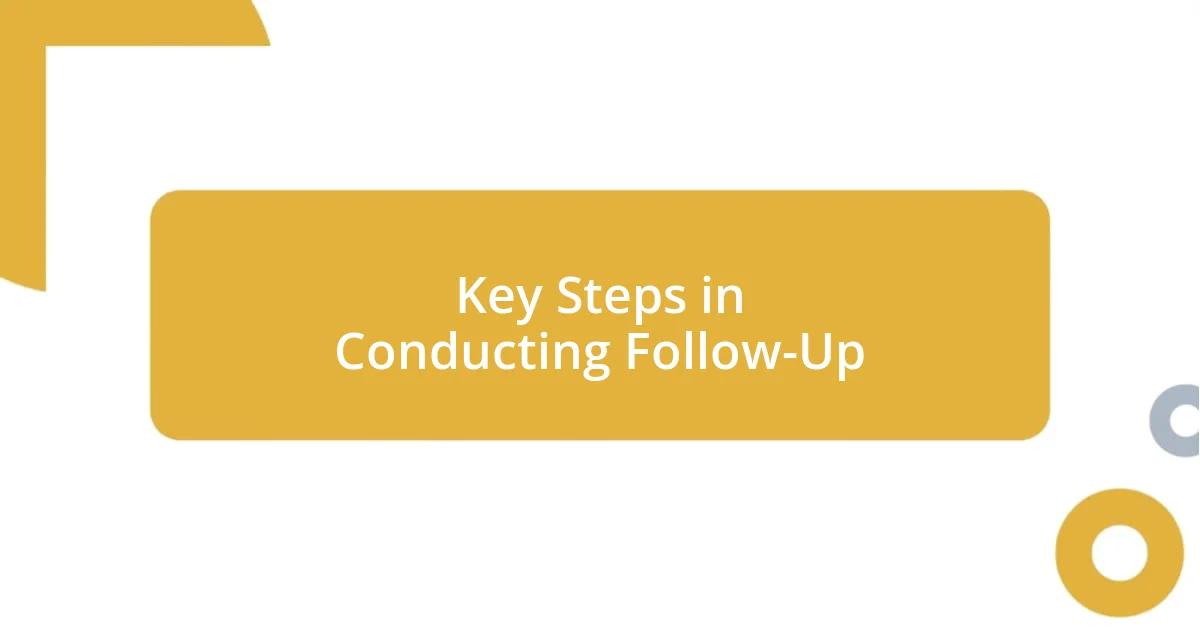
Key Steps in Conducting Follow-Up
When conducting follow-up, there are several key steps to ensure it’s effective and meaningful. For instance, I make it a point to contact participants promptly after the trial concludes. One time, I called a participant who had been hesitant during the trial, and to my surprise, she opened up about her experience and what she felt post-study. That conversation not only provided crucial feedback but also transformed her anxiety into a sense of closure and understanding.
Here are some essential steps I recommend for conducting follow-up:
- Timeliness: Connect with participants soon after the trial ends; this shows that their experience matters.
- Personalization: Tailor conversations to each participant’s journey; it strengthens the bond and the feedback received.
- Open-Ended Questions: Encourage participants to share their feelings and experiences; this method often yields richer insights than yes/no questions.
- Document Everything: Take detailed notes during follow-ups; these insights can inform future trials and improve patient care.
- Reassurance: Remind participants they are still part of the study community; it fosters ongoing engagement and trust.
Each follow-up is an opportunity to bridge the gap between clinical research and compassionate care, and I genuinely think that’s a powerful aspect of our work.

Effective Communication Techniques Used
In my experience, effective communication techniques during follow-up can truly transform participant relationships. I often rely on active listening, where I genuinely engage with what participants are expressing. There was a moment when a participant shared their struggles post-trial, and by simply reflecting back what they said, I was able to create a safe space for them to open up further. This technique not only validated their feelings but also fostered trust.
Another vital approach is the use of a follow-up framework that includes structured yet flexible conversations. For example, I developed a questionnaire that guides our dialogue while allowing for deviations based on participants’ responses. I remember one participant diverged from the planned questions and began discussing their family concerns, which gave me deeper understanding of their state of mind beyond the trial results. It’s these conversations that can reveal invaluable insights into their overall well-being.
Moreover, I’ve found that employing visual aids or informative materials can enhance understanding and retention during follow-up discussions. In one instance, I shared a simple infographic outlining possible post-trial symptoms. Not only did it clarify important points, but it also empowered participants to communicate more effectively about their experiences. This blend of clarity and support in communication makes each follow-up a meaningful experience.
| Communication Technique | Description |
|---|---|
| Active Listening | Engaging fully with participants, validating their feelings to build trust. |
| Flexible Framework | Using structured questionnaires that allow for organic conversations. |
| Visual Aids | Providing informative materials to facilitate understanding and empower participants. |
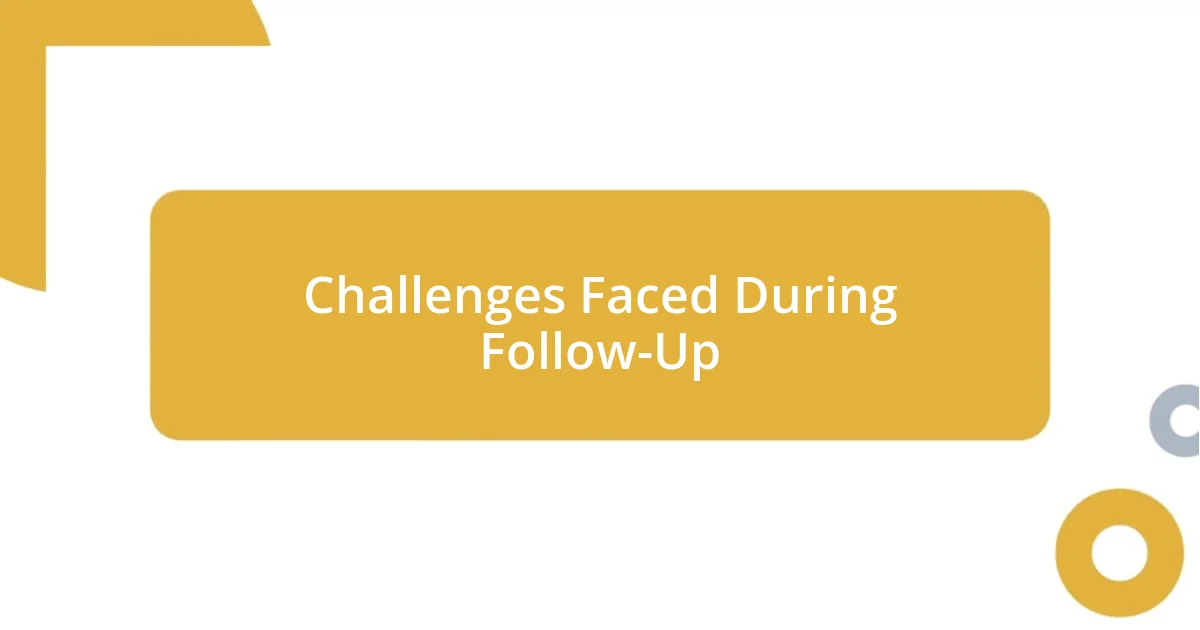
Challenges Faced During Follow-Up
One of the biggest challenges I’ve encountered during follow-ups is participants’ reluctance to share their true feelings. I remember a phone call where I sensed the participant was holding back. It made me wonder, why are some individuals hesitant to open up? It can be disheartening when you know they carry valuable insights but feel unable to express them. This experience taught me that building rapport takes time and patience, and I’ve made a conscious effort to create an environment where participants feel safe and valued.
Another hurdle arises when participants have varying levels of recall about their experiences. During one follow-up, I spoke with someone who seemed confused about basic details of the trial, which left me questioning how best to guide our conversation. I’ve realized that the emotional weight of their experience can sometimes overshadow the specifics. This realization pushed me to balance my approach by gently reminding them of key moments, while also prioritizing their emotional well-being—after all, it’s their feelings that matter most in these discussions.
Lastly, logistical issues can’t be overlooked. I’ve faced countless scheduling conflicts, with some participants completely disappearing after the trial. I often find myself pondering, how can we maintain that connection when life gets in the way? I developed a system to send reminders and check-ins, but despite my best efforts, there are always a few who slip through the cracks. It’s frustrating, yet it highlights the importance of persistence and adaptability in ensuring that every voice is heard, even if it takes a bit more time.
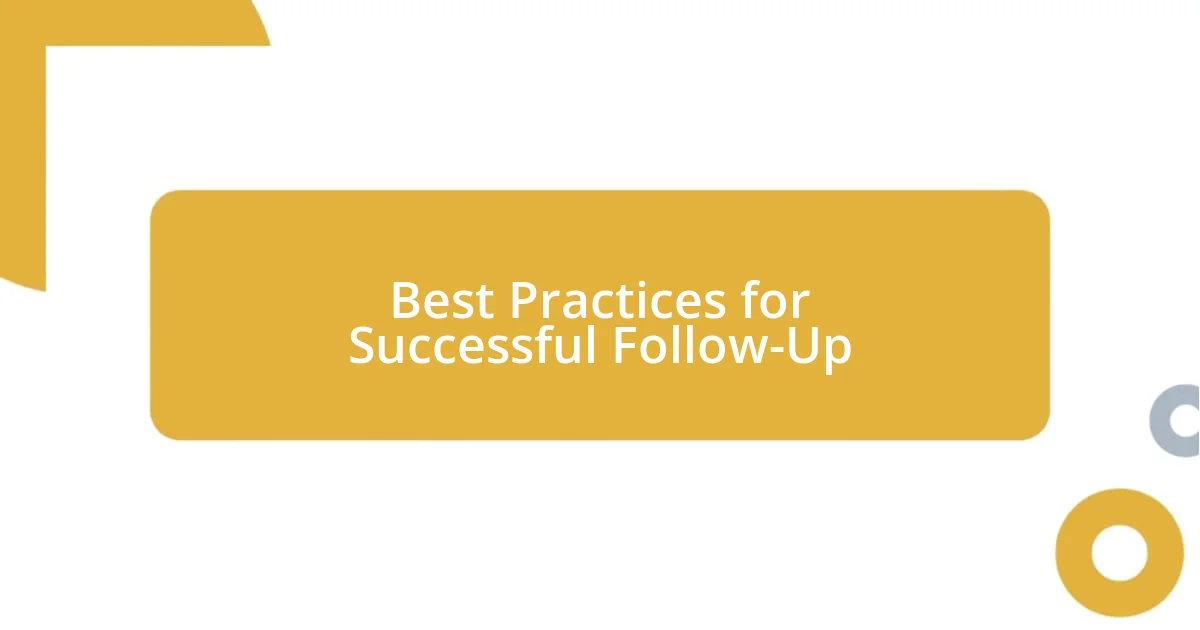
Best Practices for Successful Follow-Up
Successful follow-up really hinges on being proactive and attentive. One tactic I’ve found useful is to schedule follow-ups shortly after the trial concludes. I remember feeling relieved when I reached out to a participant just days after their experience. It was like capturing a snapshot of their thoughts; they were still processing everything and shared insights that might have faded over time. How often do we miss these fleeting opportunities by waiting too long? Timeliness can indeed make all the difference in obtaining meaningful feedback.
Another best practice is to personalize each follow-up conversation. I always make it a point to reference past discussions, which not only shows that I care but also helps participants feel valued as individuals. For instance, I had a memorable follow-up where I mentioned a participant’s earlier comment about their favorite hobby. This little detail sparked a warm conversation, and they opened up more about their feelings surrounding the trial. Isn’t it fascinating how personal touches can deepen connections and encourage openness?
Finally, I prioritize closing the loop after every follow-up. It’s crucial to not only gather insights but also to provide feedback to participants on how their input is being used. I vividly recall after one insightful discussion about concerns raised, I took the time to write a short note explaining how their input helped shape our future trial protocols. This simple act reinforced their sense of contribution and engagement, creating a feedback cycle that not only benefits the participants but also our entire research process. Isn’t it rewarding when participants feel their voices truly matter?

Utilizing Feedback for Improvement
Feedback is one of the most powerful tools at our disposal for continuous improvement. I recall a particularly enlightening session where a participant candidly shared their experience about the follow-up process. They felt overlooked and mentioned that their suggestions went unheard, which hit me hard. It made me consider, how many others may feel the same way but don’t speak up? This encounter prompted me to refine my approach, ensuring that all feedback, whether positive or negative, is acknowledged and acted upon.
One of the best ways to utilize feedback is by sharing it openly with your team. In a recent debrief, I decided to present both the praises and concerns raised during follow-ups. The team’s reaction was profound; it sparked a lively discussion about making our processes more user-centric. I couldn’t help but feel excited thinking about how this newfound perspective could lead to changes that truly resonate with our participants. Have you ever experienced the thrill of collective brainstorming sparked by shared insights? It reminds me how collaborative efforts can lead to innovative solutions.
Additionally, I learned that iterating on feedback isn’t just about making changes; it’s about fostering a culture of openness. After an especially reflective follow-up, I made it a point to initiate a monthly feedback loop with participants. Some were surprised to receive a follow-up email asking for their thoughts on our changes. This small act showcased my commitment to their input, bringing a sense of ownership back to them. When participants see their feedback shaping the process, it creates a stronger bond—one that encourages honest dialogue in future interactions. Isn’t it empowering to know that each voice can leave an imprint?
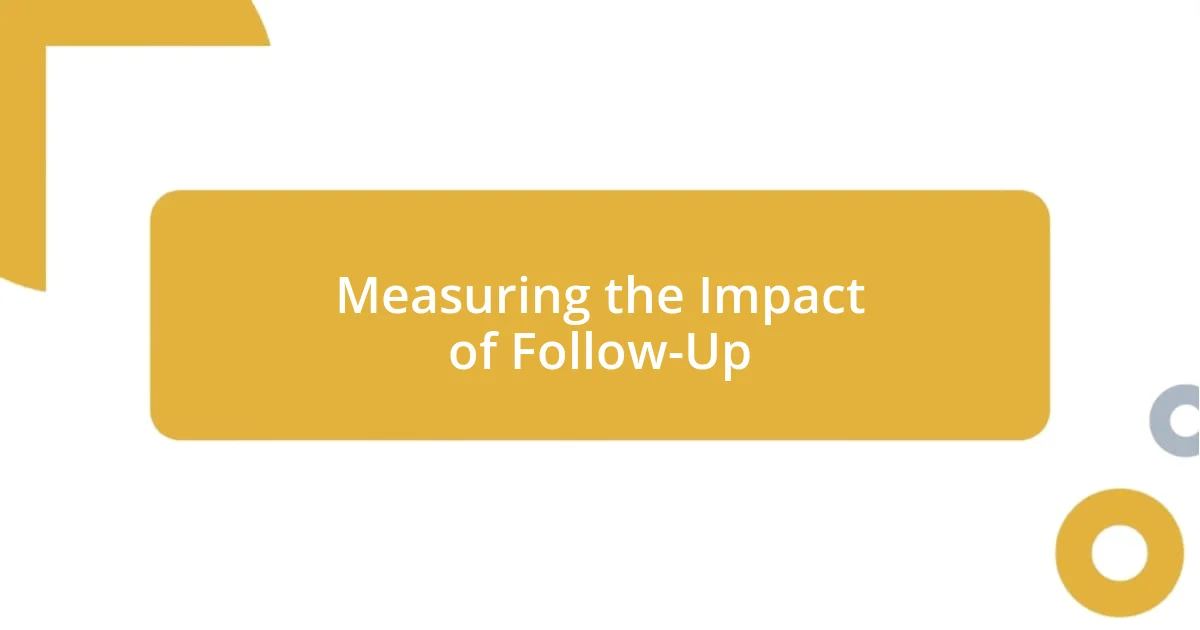
Measuring the Impact of Follow-Up
Measuring the impact of follow-up is essential to understanding how well we connect with participants. In one of my recent follow-ups, I decided to create a simple survey to gauge their satisfaction with the communication process. The insights were illuminating! Many expressed they appreciated the personal touch, while a few felt the follow-up came too soon. This taught me a valuable lesson about timing in our interactions. Have you ever realized how feedback can unveil unexpected perspectives?
Tracking changes over time can also provide concrete evidence of the effectiveness of our follow-ups. I remember comparing participant engagement levels before and after implementing some fine-tuning based on previous feedback. Surprisingly, we saw a boost in participants feeling more involved in their own trial narratives. It made me wonder, do we sometimes underestimate the correlation between meaningful follow-ups and participant satisfaction?
Lastly, I’ve found that sharing success stories with the team can be wonderfully motivating. One particular follow-up resulted in a participant who expressed how our research impacted their life positively. I shared this story in our team meeting, and you could practically feel the energy shift; everyone became more enthusiastic and committed to making each follow-up meaningful. Have you ever encountered a moment when a single story transformed a team’s approach? It reminded me that every interaction holds the potential to inspire change.










